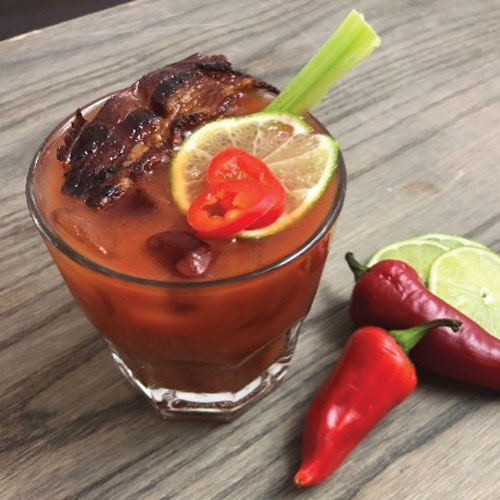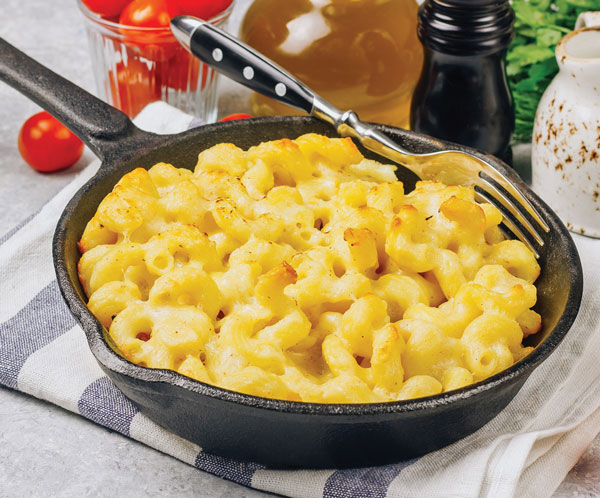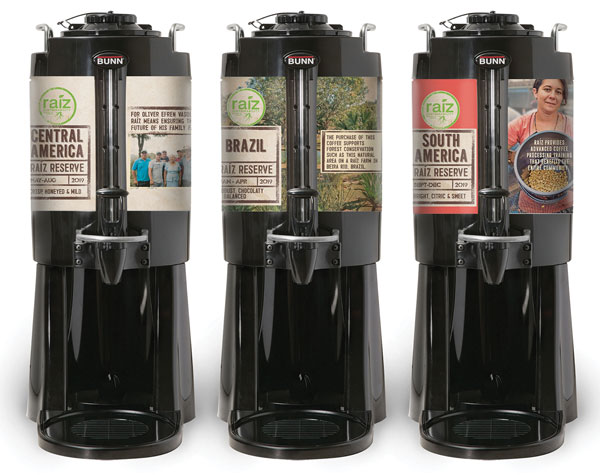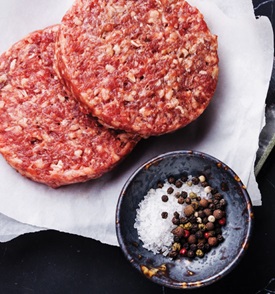
Ingredients Make a Big Impact in The Big Easy
Food expo exhibitors showcased ingredients created to help food and beverage formulators deliver on consumers’ expectations for taste, texture, and nutrition, and to solve any number of product development problems.
Article Content
With another exciting and educational IFT food expo behind us, product developers can now take everything they learned about the functionalities of various ingredients and food and beverage trends and begin to apply it to their formulation efforts. While there were any number of trends gleaned from all that was presented, one of the standouts was the importance of flavor. Flavor drives sales and adds distinction to products. People enjoy trying new flavor experiences. And flavors contribute important functions to foods and beverages. This recap of some of the ingredients that exhibitors presented begins with a discussion of three ways that food manufacturers can use flavor to their advantage to enhance products and solve formulation problems. Read on after that for insights into additional ingredients and the functions that they provide.
1. Adventures in Flavor
“Right now, I think there’s no larger macro trend than international or fusion cuisine,” observed Dax Schaefer, corporate executive chef and head of culinary innovation for Asenzya. As an example of this global infusion of flavors, Schaefer cited the pairing of Asian profiles with a traditional American dish to achieve a flavorful Asian pot roast. Another example is Asian short rib tacos,
which pairs Asian flavors with Mexican fare, a trend that is enjoying popularity on the West Coast. As a result, said Schaefer, “you’re seeing deep flavor profiles from Asia being used to create a bridge for Americans to try new products.”
At the Asenzya booth, visitors had the opportunity to try an international mashup for themselves in the form of a Korean Po-Boy. Combining spicy Korean fried chicken with a gochujang glaze, the po-boy included a custom sauce blend that bridged the flavors in a satisfying and tasty way.
“We’re also seeing a bigger push into more authentic Mexican cuisine,” added Schaefer, a move that is enticing consumers to delve a little deeper into previously undiscovered Mexican flavors and ingredients. In a vegetarian twist on a Yucatan classic, the Jackfruit Pibil concept dish prepared by Schaefer used jackfruit as the primary ingredient, combining it with a custom sauce blend and a trend-forward flavor profile.
Fermented foods are integral to many cuisines from regions around the world, such as Japan, Korea, Central and Eastern Europe, and Scandinavia. Fermented foods have been gaining traction among consumers for several years now, not only for their health benefits but for the intensity of their taste (funky and sour flavors) and clean label profile. Miso, kombucha, drinking vinegars, pickles, sauerkraut, and kimchi are some popular fermented foods. Mintel also notes that sour flavors are making their way into frozen desserts and slushies. For consumers seeking new flavor experiences, fermented foods and ingredients hit the mark. Florida Food Products debuted its new line of fermented vegetable juices, playing into consumers’ increasing interest in gut-friendly ingredients that promote the growth of good bacteria.
The new line of liquid and powdered lactic acid fermented vegetable products includes beet, carrot, onion, and mushroom—ingredients that help create tasty, on-trend flavors and work in a variety of functional food and beverage applications.
The centerpiece of Florida Food Products’ fermented ingredient line is its beet juice, whose health benefits were recently outlined in a company white paper. The juice possesses a pleasing fruitiness while reducing the earthiness associated with beetroots. It adds an attractive color and unique flavor to formulations while keeping sugars low and labels clean.
“Fermented ingredients offer brand owners an opportunity to create or reimagine their products to align with their customers’ desire for clean label, authentic products,” observed Christopher Naese, vice president of business development. “We’ve been a leading supplier of fruit- and vegetable-based ingredients for over six decades, and the entrance into the fermented ingredient market was a natural step for us.”
Another way to be adventurous with flavor is to turn up the heat. Boldness has been a mainstay of McIlhenny Co., makers of TABASCO brand products and experts at drawing out the complexities of savory and sweet foods and beverages. The company’s line of sauces spans a variety of applications, inspiring new flavor profiles and enhancing existing products. Among the featured products was the company’s TABASCO brand Scorpion Sauce, which booth visitors could sample as part of a spiced-up pineapple topping for ice cream sundaes.
Other product highlights included the company’s signature Original Red Sauce, handcrafted with premium ingredients to deliver a sauce that adds flavor dimensions to any application, and Sriracha Sauce, a zero-fat, preservative- and gluten-free formulation that elevates flavors. For a milder taste, TABASCO brand’s Garlic Pepper Sauce blends garlic with three distinct peppers—smooth cayenne, mellow red jalapeño, and a small amount of oak-aged TABASCO Pepper Mash.
Also featured was McIlhenny’s popular Chipotle Sauce in a new spray-dry form. The chipotle pepper enjoys a history dating back to the ancient Aztecs, who smoked red jalapeño peppers. Following in the Aztecs’ tradition, McIlhenny lets the peppers slow-dry in pits over fires fueled by locally harvested pecan wood, then adds its own time-honored tradition to create the smoky, flavorful sauce. The new spray-dry flavoring can add excitement to seasoning blends, enhance beverage ideas, or spice up sweets, and is sure to appeal to adventurous consumers looking for an exciting taste experience.
2. Layering Flavor
When it comes to the flavor of food and beverage products, manufacturers and chefs are experimenting with complementary flavors and layering sweet, sour, umami, bitter, and even sensations like coolness and heat. One chef in particular says she is excited to see consumers’ taste preferences evolve to where they are actually seeking out new taste experiences. Heat is one of those taste sensations that people enjoy. But Juliet Greene, a chef with Charlie Baggs Culinary Innovation, said it’s moved beyond in-your-face heat sensations. The key, she said, is to layer heat with other flavors like sweet or sour.
 Greene formulated several product concepts for Mizkan, drawing on the company’s portfolio of chili pepper ingredients, vinegars, and denatured spirits, that illustrate how combining flavors results in taste-tempting, on-trend products. Some noteworthy ones included grits topped with carnitas featuring Mizkan’s Hatch Green Chiles, Denatured Tequila, and Organic Apple Cider Vinegar, and roasted vegetable succotash with jambalaya-inspired couscous made with Mizkan’s Rio Luna Diced Jalapeños and Organic Apple Cider Vinegar.
Greene formulated several product concepts for Mizkan, drawing on the company’s portfolio of chili pepper ingredients, vinegars, and denatured spirits, that illustrate how combining flavors results in taste-tempting, on-trend products. Some noteworthy ones included grits topped with carnitas featuring Mizkan’s Hatch Green Chiles, Denatured Tequila, and Organic Apple Cider Vinegar, and roasted vegetable succotash with jambalaya-inspired couscous made with Mizkan’s Rio Luna Diced Jalapeños and Organic Apple Cider Vinegar.
Greene also mentioned that sour and fermented flavors are trending. Three nonalcoholic shrubs featured the bright flavors of some of Mizkan’s vinegars: Organic Apple Cider Vinegar, Organic Rice Wine Vinegar, and Organic Red Wine Vinegar.
Kalsec, too, showed how layering flavors is a great food formulating strategy. Hot, spicy, herby, and pungent ingredients have their own specific and nuanced flavors that can be used to create taste-tempting flavor profiles, explained Gary Augustine, executive director of market development. The company, which manufactures spicy and hot ingredients like garlic and onion extracts, capsicum extracts, spice and herb extracts, and chili pepper extracts, let booth visitors customize their own snack mixes with various nuts, cereal pieces, jerky, crackers, and chocolate flavored with some of these extracts. The adventurous ones jumped right in to create their preferred snack mix. But for those who needed some guidance, Kalsec had several suggested combinations. A mix of blood orange chocolates and chipotle almonds produced a sweet and smoky snack while Szechuan pepper corn pops, ginger white chocolate bark, and capsicum cereal pieces formed a heat-forward, gingery snack. Mixing horseradish cheese crackers and black pepper beef jerky with cumin potato sticks and ginger white chocolate bark made a crunchy snack with the flavor of a bold steak sauce.
Synergy Flavors put its own spin on layering flavor by inviting attendees to enjoy flavor experiences of the past, present, and future. For example, product concepts representing flavors from the past evoked nostalgia with flavor combinations such as vanilla and caramel in a vanilla caramel cold brew beverage, molasses and ginger in a switchel, and fruit cereal flavor in a mini bundt cake with cream cheese frosting. Product concepts positioned as being on trend for today showed how layering flavors can elevate an otherwise traditional food product. These included marshmallows in watermelon pear flavor, clementine vanilla flavor, and cold brew coffee flavor with dark chocolate drizzle. In the future, expect to see a greater emphasis on customization of everything, including food and beverage products, according to Synergy Flavors. That’s why booth visitors were invited to take a short quiz, and then receive a personalized ice cream sundae based on the results. Some of the flavor combinations of the sundaes included animal cracker waffle cookie/birthday cake frosting and graham cracker granola/burnt caramel cold brew coffee shot.
3. Improving Taste
Finally, food manufacturers can use flavor ingredients to enhance the perception of saltiness or sweetness in foods and mask off-flavors or unwanted bitterness. Take the work that Virginia Dare does with customers to formulate products that deliver on preferred taste through its Taste Foundations and Taste Collaborations platforms as an example. One of the ways the company does this is through developing extracts (vanilla, tea, coffee, cocoa, and botanical) that not only add flavor to products but also improve and modulate taste.
The keto diet is popular among some consumers. The diet is focused on consuming protein and limiting sugar and other carbohydrates. Ingredients often used in foods positioned as keto diet–friendly are plant-based protein ingredients and alternative sweeteners. However, some of these ingredients have off-flavors. Here’s where flavor extracts come into play. Virginia Dare formulated cookies with its vanilla extract and natural flavors to add flavor to the cookies and to modulate some of the off-flavors associated with other ingredients. Attendees could choose from a lemon lavender turmeric or cinnamon cookie.
The number of consumers digging into plant-based foods continues to increase, providing opportunities for food product developers to offer satisfying taste and indulgent richness, objectives that can be tricky to achieve with dairy-free applications. But at Edlong, flavor is front and center when it comes to both dairy and plant-based formulations, as witnessed by the delicious prototypes on hand at IFT19.
Highlighting “the science of surprising,” the company featured a Lemon Feta Cottage Cheese Frozen Dessert With Lemon Basil Cookie. A light, indulgent dessert made from a cottage cheese base, the creamy confection delivered all the taste of a cheesecake but without the fat found in traditional ice cream.
“The art of vegan” was embodied in Edlong’s Vegan Cheese Bread, a gluten-free dipping bread paired with a Flight of Vegan Cashew Dips highlighting “the science of creaminess.” The bread’s subtle cheese taste added enhancement without overwhelming the vegan dips, each of which stressed a different flavor: Zesty Sour Cream featured a mild tabasco pepper; Aji Amarillo Emmental played up Peruvian spices; and Butter Curry delivered rich global flavor.
Through continual research and innovation, Edlong works to solve some of the most difficult taste challenges, capturing the richness, creaminess, and indulgence of dairy—even in plant-based applications. The company offers more than 250 natural, vegan flavors that are capable of contributing authentic dairy taste, masking off-notes from plant-based ingredients, or building back richness into food and beverage applications.
 Putting a new spin on an American classic, Salt of the Earth treated visitors to an even more craveable version of mac and cheese made with Mediterranean Umami, a clean label, all-natural flavor enhancement that allows for a reduction of cheese while maintaining the same delicious flavor.
Putting a new spin on an American classic, Salt of the Earth treated visitors to an even more craveable version of mac and cheese made with Mediterranean Umami, a clean label, all-natural flavor enhancement that allows for a reduction of cheese while maintaining the same delicious flavor.
Salt of the Earth completed multiple trials of macaroni and cheese formulations with and without Mediterranean Umami at its applications lab, with two chefs working jointly to preserve identical taste between the products. The flavor enhancement qualities of Mediterranean Umami maintained the true flavor of the dish, but with 10% less cheddar cheese, and without using MSG or yeast extracts.
“After feedback from customers, who were reporting significantly stronger flavors, we started exploring the capacity of Mediterranean Umami to reduce ingredients and contribute to cost savings,” said David Hart, business unit director. “Surprisingly, we not only succeeded in maintaining full flavor with Mediterranean Umami, we actually crafted a mac and cheese that was even more craveable.”
Winner of the IFT17 Innovation Award, Mediterranean Umami is a versatile ingredient with multiple uses; it can boost savory flavors, enhance overall flavor profiles, and reduce sodium. It can also be used to reduce the amounts of certain expensive ingredients, such as flavorings and spice blends, mushrooms, or parmesan and other cheeses.
In addition to preparing mac and cheese samples, chefs Osher Eidelman and Jeff Rotundi offered samples of a vegan meatball and beef bone broth, two examples of flavorful foods with natural ingredients and reduced sugar, fat, and sodium. The innovative prototypes showed how manufacturers can leverage the power of plants and natural flavors to create clean label products with simple ingredients that retain robust flavors.
Finally, at the Sweet Green Fields booth, the company showed how its Thaumagic ingredient is changing the taste of sugar-free. The flavor provides a multisensory experience by modulating the perception of sweeteners and creating a superior overall taste profile. Suitable for use as a sweetener or a taste-modifying protein, it interacts with taste receptors on the tongue and changes food perceptions in different ways.
Thaumatin is extracted from the katemfe fruit, which originates in West Africa. The fruit has been used as a sweetener for centuries and conforms to consumer preferences for natural and clean label ingredients.
Thaumagic features a natural aroma that impacts retro-nasal olfaction, resulting in a recollection of the aroma in the oral cavity after the drink is swallowed. The recollection enhances taste perception and can be used in a variety of beverages, including energy drinks, carbonated drinks, or coffee.
Sustainably Sourced Coffee
 According to Conservation International, 150% more coffee will be needed by 2050 in order to meet demand. In response to the looming crisis, S&D Coffee & Tea has introduced a new line of sustainably sourced coffees, which were highlighted at IFT19 as part of the company’s Raíz Sustainability sourcing platform. The products are the first 100% sustainably sourced coffees to be produced with both the S&D Coffee & Tea and Raíz branding.
According to Conservation International, 150% more coffee will be needed by 2050 in order to meet demand. In response to the looming crisis, S&D Coffee & Tea has introduced a new line of sustainably sourced coffees, which were highlighted at IFT19 as part of the company’s Raíz Sustainability sourcing platform. The products are the first 100% sustainably sourced coffees to be produced with both the S&D Coffee & Tea and Raíz branding.
The Raíz Sustainability platform is part of S&D’s efforts to improve the lives of small-scale coffee growers while ensuring the company meets its own sustainability goals. The inclusive approach provides smallholder farmers, who may not otherwise qualify for certifications, with immediate access to training and technical assistance to help adopt best practices in agriculture and business management. Working with clusters of farmers in multiple origins, S&D has produced its line of Raíz Reserve coffees, which are exclusively available as seasonal offerings, guaranteeing peak freshness and quality.
The new varietals include a crisp, medium/light roast with hints of honey from Central America and a bright, citric, and sweet medium roast from South America, to be introduced in September 2019 and remain available through the end of the year. The new launches follow the recently released robust Brazilian dark roast.
“We are very proud to be launching our first line of exclusively sustainably sourced coffees from the family of Raíz farmers in three origins,” said Olga L. Cuellar-Gomez, head of S&D sustainability efforts. “This launch is a testament to the power and potential of the Raíz Sustainability platform, and we look forward to continuing our efforts with more 100% sustainably sourced coffee offerings in the years to come.”
New Chapters in the Stevia Narrative
Since the introduction of the first stevia extracts a little more than a decade ago, the stevia story has continued to evolve, and at IFT19, PureCircle team members shared information on some of the latest chapters.
Over the years, research has revealed the presence of additional sweet molecules within the stevia plant (beyond the initially introduced Reb A glycoside). Last year the company announced that it had developed a proprietary strain of the stevia plant called Starleaf, which delivers more of the Reb M glycoside. Reb M, which is 200 to 300 times sweeter than sugar and has less of an aftertaste than the stevia glycosides that were available earlier, has opened the door to new product formulation options.
That’s not where the stevia saga ends, however. Mapping the full genome of the stevia plant, which the company announced in 2017, has contributed to the discovery of additional functional compounds within the plant, including fiber and protein, and PureCircle is working on learning more about how to use them as ingredients, said Sue Bancroft, group vice president.
Along with a variety of stevia glycosides, the company also offers a line of flavor modifiers, Pure Circle Natural Sweet Flavors, which not only have the ability to mask flavor off-notes but also to enhance other flavors, such as fruit flavors, said Bancroft.
Stevia use in food and beverage formulations has expanded significantly. The number of new products formulated with stevia shot up 31% in 2018, according to Mintel data PureCircle supplied. It’s extended well beyond beverages, said Bancroft. At the food expo, PureCircle showcased the sweetener in a taste-tempting assortment of frozen dessert flavors.
The company partners with growers in China, Africa, South America, and North Carolina through its agronomy program. Plans are in place to significantly increase stevia growing acreage in North Carolina over the next two to three years, providing a new option for farmers who once grew tobacco.
Ingredients for Better-for-You Foods
As consumer food and beverage preferences continue to evolve, ADM demonstrated how its comprehensive portfolio of ingredients can help manufacturers formulate products that consumers want now and in the future.
Products such as those that carry a “better-for-you” image are growing in popularity among many consumers. ADM featured a range of its ingredients in product concepts that promised such nutritional benefits as reduced sugar, gut health, brain health, fiber, and protein. For example, a gluten-free cookie and a kombucha bite were formulated with gut health–promoting ingredients like fiber and probiotics. SweetRight Edge stevia provided a sweet taste without the calories of sugar in a sugar-free sweet tea beverage. A banana bread bite was formulated with omega-3 fatty acids (specifically docosahexaenoic acid), which is an important nutrient for brain health. Chickpea ingredients are increasingly being used to enrich snack foods with plant protein. ADM showcased its chickpea ingredients in a savory nutrition bite. The snack also included fiber and ancient grains.
Black Walnuts Elevate Products
Plenty of chefs and product developers are already fans of the bold and distinct flavor of black walnuts, and representatives from Hammons Products Company were on hand at the food expo to introduce others to this uniquely American tree nut.
A completely wild crop, American black walnuts grow throughout the Midwest and East Central United States. Another interesting fact about the nut is that they are harvested entirely by hand, said Jacob Basecke, vice president of sales and marketing at Hammons Products Company. He added that the flavor and nutritional profile of the nut makes it an attractive ingredient in a wide range of applications. The flavor is bold and earthy, with a creamy finish, and does not have the slight bitterness that English walnuts can have. As far as nutrients are concerned, black walnuts are high in protein, phytosterols, and antioxidants. They’re perfect in bakery applications (samples of cookies made with chopped black walnuts were available to attendees), salads, savory side dishes, entrées, and snack foods.
Multifunctional Flavors
Crave-worthy buttery and cheesy flavors are possible with flavors from Butter Buds Food Ingredients. This year, the company focused on how both its dairy and nondairy flavors can enhance flavor, richness, and mouthfeel in products. There were even options that help mask off-notes of certain plant protein ingredients.
The nondairy flavor ingredients that the company manufactures are designed to provide desired dairy flavors without the dairy allergen. Several of these flavors were formulated into product concepts served at the company’s booth. A buttery chicken curry nondairy entrée featured Non-Dairy Buds Ghee Type and Non-Dairy Buds Asia. Keto bites were made with Non-Dairy Butter Flavor and Butter Buds 8x Non-Dairy LD. Michael Ivey, Butter Buds’ national sales director, said that the nondairy line of flavors is the fastest growing in the company’s overall portfolio.
Experts were on hand to discuss the company’s range of flavors, which include Cream Buds and Milk Buds concentrated dairy flavors, Cheese Buds concentrated cheese flavors, Butter Buds butter concentrates, and nondairy flavors like Butter Buds Bacon, CocoaButter Buds, dried beer extract, and Olive Oil Buds. The company also served two sweet treats: malted bark with pecans made with Butter Buds Sautéed Butter Flavor (Natural) and an iced kringle that featured Natural Ghee Buds.
Making Food Tasty and Safe
Several ingredient solutions from DSM give manufacturers options when trying to enhance and improve the flavor of food products, while others help foods stay fresher longer.
Multirome provides savory flavor enhancement and gives a fatty mouthfeel and umami taste to savory foods, such as the Cheddar scallion corn muffin product concept. The ingredient also works in sodium reduction efforts and clean label initiatives.
A Vegetarian Buffalo Chick’n Dip product concept highlighted a couple of yeast extract–based ingredients that enhanced the flavor of the non-meat product. Maxavor Chicken YE/Roast 11815 gave the meat analogue, in this case textured wheat gluten, a chicken taste with a boost of umami taste. It also gave light roasted flavor notes. Maxarome yeast extracts were used to round out and balance the overall taste profile of the dip. Some of the specific benefits that the Maxarome yeast extracts provide are a rich savory taste, mouthfeel, off-note masking, and sodium reduction. Ingredients in both the Maxavor and Maxarome lines are vegan, allergen-free, and not genetically modified.
DSM also showcased its entire line of biopreservation ingredients, which provide food manufacturers with naturally derived ingredients to extend the shelf life and maintain texture and taste of dairy, beverage, and bakery applications. For example, DSM’s Delvo Guard cultures give dairy products a longer shelf life at both ambient and chilled temperatures. The company points to results of tests that show Delvo Guard cultures extended the shelf life of a sweet yogurt at ambient temperatures by up to two weeks and helped preserve yogurt for longer in warmer climates where cool transport options are limited without affecting the product’s taste and appearance. In addition to cultures, the biopreservation line includes enzymes and fermentation-based solutions.
Focus on Food Trends
Ingredion organized its booth into three themed stations where attendees could interact with Ingredion experts to learn about plant protein, sugar reduction, and clean labels, three areas that address trends in global consumer eating behavior. And, of course, there were plenty of product concepts that demonstrated the functionalities of ingredients from Ingredion, TIC Gums, and Kerr Concentrates.

Plant-based food sales increased 20% (from 2017 to 2018) with sales topping $3.3 billion, according to the Plant Based Foods Association. Ingredion offers a range of plant protein ingredients such as plant-based isolates, concentrates, and flours. Its new VITESSENCE Pulse 1803 organic pea protein isolate is made by a water-based extraction of yellow peas and contains a minimum of 80% protein content on dry matter basis. The ingredient was featured in a high-protein vegan cheese spread and organic high-protein pasta noodles product concepts. Another pea-based ingredient is PURITY P1002 pea starch, which offers functionalities such as gelling and film forming properties. It’s also neutral in color and flavor. It was combined with nothing more than water to formulate gluten-free cellophane noodles.
Sugar reduction is top of mind for product developers. Ingredion points out Mintel’s 2017 Sugar Reduction Trends report that states that consumers are reducing their sugar intake and checking labels for sugar content. For the first time, Ingredion offered ASTRAEA Allulose, a sweetener that is about 70% as sweet as sugar and offers similar functionalities like bulking, browning, and freeze point depression, according to the company. It was formulated in a vegan frozen dessert. The frozen dessert has 15 grams of sugars per 102-gram serving. Ingredion had information about a control made with traditional 42DE syrup that showed 22 grams of sugars per 102-gram serving. The company has other sweeteners to help manufacturers reduce added sugars in formulations. BESTEVIA Reb M stevia leaf sweetener helped produce a blackberry mint cocktail base with a 50% sugar reduction and a no-sugar-added mango lime and chili dessert topping, while ENLITEN Fusion 7200 stevia leaf sweetener allowed for targeted sweetness and a clean sensory profile in a reduced-sugar sweet chili lime dipping sauce.
Finally, the company showed how some of its starches can produce appealing textures and aid in stability over shelf life while meeting clean label demands of consumers. For example, NOVATION PRIMA 609 organic functional corn starch, which was featured in an organic chamoy sauce and an Indonesian wok sauce, can be labeled as “organic corn starch.” In these two applications, the starch delivered cold temperature stability and produced sauces that had smooth textures. Its HOMECRAFT Create 865 multifunctional rice flour produced smooth and creamy tahini sauce dressing and Tunisian shakshouka tomato sauce. The ingredient is labeled “rice flour.” Sauces demonstrate the functionalities of starches, but so do foods like crackers. Ingredion used PRECISA Crisp 930 texturizer, an ingredient based on corn, tapioca, potato, and sago starches, to formulate beet crackers. The dough had even expansion and improved sheetability, and the crackers themselves had an enhanced crunch and reduced breakage thanks to the texturizer.
Insights Into Clean Label
Clean label is where it’s at. About three-quarters of consumers are “extremely likely”/“likely” to seek clean label products, according to Cargill proprietary research. The research also found that familiar ingredients are the No. 1 attribute associated with clean label. Findings like these support the development of so-called clean label ingredients, which is why Cargill introduced the latest label-friendly additions to its line of functional starches.
The SimPure 994 collection of label-friendly functional starches gives manufacturers the functionalities they need and consumers the type of recognizable ingredients they want. There are starches in the line that are designed to bring specific textures and shelf-life stability to frozen ready meals; dairy foods, such as custards and puddings; and ambient/chilled soups, sauces, and gravies. The starches hold up in gentle cooking conditions, pasteurization, homogenization, UHT, and retort. The starches replace modified starches in formulations, are sourced from waxy corn, and are labeled as “starch” or “corn starch.”
Fruit Derivative for Sugar Reduction
As the discussion about overconsuming sugar and possible health problems continues, some consumers are demanding more reduced-sugar food and beverage products be made available. Baby Boomers are driving this, with one in two U.S. members of this demographic reducing their sugar intake or buying more reduced-sugar products and two in five cutting back on their consumption of sweet snacks, according to Innova Market Insights. With sugar reduction on the minds of consumers, product developers need ingredient solutions for formulating products with less added sugar.

One of these solutions highlighted at the IFT19 food expo was Fruitlift, a fruit-based ingredient that replaces refined sugars in ready-to-eat cereals. The liquid-based ingredient is made up of 90% fruit components and gives cereal a mild sweetness. A proprietary technology is used to integrate the wet fruit solution into the dry flour mix used to make extruded cereal pieces, said Michal Katzir Emek, international marketing director for Gat Foods. It can also be used as a coating sprayed into the coating drum. In either case, the flavor notes (apple, apple-orange, apple-mango-citrus, pineapple, citrus, and lemon) and sweetness levels can be adjusted to meet desired taste preferences.
 A Sweet, On-Trend Solution
A Sweet, On-Trend Solution
The answer to consumers’ search for a guilt-free way to enjoy sweetness without the calorie load or aftertaste may lie in Tate & Lyle’s DOLCIA PRIMA Allulose, which offers the bulk, texture, and clean, sweet taste of sugar but with only 0.4 calories per gram.
Recently, the U.S. Food and Drug Administration (FDA) excluded the sweetener from the ‘Total’ and ‘Added Sugars’ line on the Nutrition Facts panel in the United States, which means that food and beverage manufacturers can deliver both calorie and sugar reduction in products using allulose.
“The FDA’s decision makes our DOLCIA PRIMA Allulose an even more valuable tool in the formulator’s toolbox, clearing the way for our food and beverage customers to reap the full reward for incorporating allulose into their products,” said Abigail Storms, vice president, sweetener platform innovation at Tate & Lyle.
Allulose is one of many rare sugars that exist in nature in very small quantities. It is 70% as sweet as sugar and has the same onset, peak, and dissipation of sweetness as sugar. Originally identified in wheat, it has since been found in certain fruits, including figs and raisins.
Prior to the FDA’s guidance, allulose was required to be included in the ‘Sugars’ and ‘Added Sugars’ lines of the Nutrition Facts panel. From now on, it will continue to be included in the carbohydrate line and labeled simply as allulose in the ingredients list.
“Our regulatory, legal, nutrition, and marketing teams have worked with the FDA to show the potential health benefit that allulose could have for U.S. consumers, if labeled in a clear and appropriate way,” added Storms. “It’s very rewarding to receive this decision and unlock the great potential that allulose has to reduce calories in a significant way while delivering great taste and functionality.”
Almond Inspiration
New almond product introductions across the confectionery, snacks, bakery, bars, and cereal categories make up an 80% share of global almond introductions, according to Innova Market Insights’ 2018 Global New Product Introductions Report as cited by the Almond Board of California. Almonds are also a healthy ingredient; an ounce of almonds contains 6 grams of protein, 4 grams of fiber, 75 milligrams of calcium, and 7.4 milligrams of vitamin E. All of this means greater opportunities for the use of almonds and almond ingredients in food and beverage products.
Rob Corliss, research chef with the Almond Board of California, designed recipes for a variety of almond-based product concepts to highlight the versatility of almond ingredients. A couple worth noting here are a toasted grains and almond beverage and a chewy almond powder cookie. The base of the beverage was, of course, almond milk. To this, Corliss blended in toasted grains, freeze-dried strawberries, freeze-dried dragon fruit powder, and agave for a fruity, thick, and creamy drink perfect for consumption any time of the day. The almond cookie featured creamy almond butter and almond flour. Chickpeas joined in the plant-protein base, and dark chocolate chips added to the indulgence. Cookies like these are perfect as a snack or even for breakfast.
 Antioxidants Extend Freshness
Antioxidants Extend Freshness
Helping to keep foods fresher and safer longer is the focus of Kemin’s clean label solutions. Among the applications showcased at IFT19 was an extensive portfolio of shelf-life solutions for corn and flour tortillas and flatbreads.
“Tortilla manufacturers face a host of challenges and concerns, including food safety, shelf life, texture, appearance, processing, and consumer appeal of their products,” said Courtney Schwartz, marketing director. “Not only do our solutions answer safety, textural, and processing challenges, they can also help tortilla manufacturers meet label-claim goals. Kemin offers cleaner label, non-GMO, and a wide variety of naturally sourced options that support consumer demand for and growth of organic and Non-GMO Project Verified tortilla varieties.”
Visitors to Kemin’s booth learned about the company’s complete drop-in solutions, which featured blends of several functional ingredients to contribute quality characteristics; enzyme, emulsifier, and gum blends with functional minor/micro ingredient solutions for leavening, softening, and preservation of tortillas; and mold inhibitors in liquid and dry solutions.
Other clean label innovations featured at IFT19 included fat and oil solutions designed for snack food and bakery products, such as Kemin’s GT-FORT, a consumer-friendly line of GRAS plant extracts that assists with oxidation control by significantly delaying lipid oxidation to lengthen shelf life and maintain brand consistency. For meat and poultry challenges, Kemin showcased a robust line of color, flavor, and antimicrobial solutions, making it a one-stop shop for shelf-life extensions and food safety options.
Personalized Nutrition Gets Tasty
Visitors to the IMCD Food & Nutrition booth enjoyed a sampling experience that explored the latest trends in personalized nutrition while showcasing the company’s creative formulations. “Discoveries in Taste” offered mini meals designed to entice adventurous consumers and inspire food formulators to develop their own market innovations.
A Slow Release Protein Recovery Bar featured high-quality, slow-releasing proteins that are ideal for post-workout recovery. Featuring a rich, iced-coffee flavor, the bar was designed as a long-lasting, convenient, and nutritious snack that can be enjoyed after working out or before bed.
The Gluten-free, Protein-Enriched Loaf Cake contained a combination of functional ingredients to produce a high-quality loaf cake with added protein. Free from gluten, soy, and dairy, the cake provided 6–10 grams of protein per serving with hints of vanilla and maple to enhance the flavor profile of the cake.
A keto-friendly snack, the Truffle Bomb showcased a high-fat nutritional powder (MCT) with a creamy texture and a clean taste—all with an unexpected pop of hibiscus flavor. MCT oils and powders have been shown to promote weight loss, act as a source of energy for the brain, and help to promote fat use for energy in those following a ketogenic diet, according to the company.
Pea Protein Goes Mainstream
Headquartered in Belgium, Cosucra is a 169-year-old company that produces nutritional ingredients extracted from chicory roots and yellow peas. At the expo, visitors could learn about the company’s line of pea-based proteins, including NASTAR, a highly functional, clean label native starch extracted from locally grown yellow peas by a chemical-free process; Swelite pea cell-wall fiber, a natural functional ingredient composed of dietary fibers and starch; and Pisane, a range of highly pure pea protein isolates that provide high levels of nutrition and functionality.
Among the product concepts highlighting the taste and functionality of the company’s pea-based proteins were Oat Chocolate Gluten-Free Cookies made with NASTAR for a neutral taste and color; Nutritious Almond Pea Milk made with Pisane, which offered all the benefits of a plant-based beverage, including 9.8 grams of protein per serving; and the company’s twist on an authentic New Orleans classic, the Plant-Based Muffuletta Slider, made with Pisane, NASTAR, and Swelite.
“Cosucra sees the consumer demand for plant-based food becoming more mainstream,” said Frank Truong, general manager. He pointed to recent studies that show consumers’ concern about climate change growing along with their desire to create a positive impact on the environment through their choice of foods, adding, “We see these macro trends helping to sustain the demand for plant-based nutrition well into the future.”
 Lipid Solutions for Plant-Based Foods
Lipid Solutions for Plant-Based Foods
AAK featured an expanded portfolio of multifunctional fat and oil solutions, including a new global brand for plant-based foods.
The ingredients in the AkoPlanet line allow manufacturers to formulate plant-based, dairy-free foods with decadent textures and pleasant mouthfeel. AAK featured AkoPlanet oils in two product concepts. The first, a plant-based vanilla soft-serve frozen dessert was formulated with AkoPlanet CNO 16-003 ORG, an organic coconut oil, which offers a clean, non-masking flavor so the vanilla flavor of the soft-serve frozen dessert comes through. It also contributes to the creamy texture of the product—there’s no hint of gumminess or graininess.
The second product concept was slices of plant-based cheese made with AkoPlanet PBC 28-001 ORG. The ingredient is a blend of organic coconut oil and organic sunflower oil. In an application such as plant-based cheese, this particular blend of oils helps the slices to better hold their shape, improves the mouthfeel and flavor release, and contributes to easy slicing and shredding.
Grain Goodness
Once again, Ardent Mills rolled its Mobile Innovation Center into town, a state-of-the-art culinary center from which chefs and company experts served up an array of grain-based product concepts. It also gave the team at The Annex by Ardent Mills—which celebrated its one-year anniversary—the opportunity to talk about the current market for specialty grains and plant-based ingredients and what new grain innovations manufacturers can expect in the future. One of its latest ingredients is Colorado Quinoa. Ardent Mills is the exclusive source for this sustainable, U.S.-grown white quinoa from the San Luis Valley in Colorado.
Tasting product concepts made with this grain and others is the best way to experience their flavors and textures. While there were concepts such as a smoothie made with grains, including Pure-Purple Barley, and small slices of Neapolitan-style pizza made with Primo Mulino Italian Style Flour, several others drew on the rich culinary traditions of New Orleans. One was jambalaya made with a blend of Ardent Mills’ IQF grains like quinoa, white Sonora wheat, black barley, and Sustagrain high-fiber barley. These pourable, fully cooked grains are perfect for heat-and-serve applications. The Colorado Quinoa made an appearance in grits form and was cooked up with savory ingredients and paired with shrimp. Boudin and gumbo product concepts featured some of the company’s ancient grains (amaranth, sorghum, quinoa, millet, buckwheat, and teff).
New Shortenings Improve Texture
A new line of specially designed shortenings from Bunge Loders Croklaan promises to improve the functionality, appearance, and mouthfeel of icings, doughnuts, and tortillas.
The three Vream Specialty Shortenings, which made their debut at the IFT19 food expo, have neutral taste, a wide temperature tolerance, and a smooth consistency, making them easy for manufacturers to work with and incorporate into formulations. They can also be used as drop-in replacements for conventional shortenings.
The one for icings has a bright white appearance and a light texture. An important quality of this shortening is that it eliminates post-hardening, leading to a better mouthfeel and longer shelf life. Blood orange cupcakes and strawberry cream cakes featuring the Vream icing shortening were served at the booth.
There’s another Vream shortening for use in doughnuts, where it enhances the adhesion of glazes and icings and reduces cracking of glazes. These functionalities were demonstrated in an espresso toffee doughnut product concept. The third shortening in the Vream lineup improves the rollability of tortillas. This helps to reduce tears and ensures a soft tortilla. Visitors to the booth could sample queso chimichangas, tacos, and muffuletta gnocco frittos to experience the improved texture that the shortening helps to produce.
Many Shades of Appetizing
A vibrantly colorful array of candies, lollipops, popcorn balls, and beverages on display at Roha’s food expo booth allowed the company to effectively showcase its capabilities with natural and synthetic colors.

The company, which originally established itself in the synthetic colors business, has been expanding its presence in the natural colors arena. Roha’s natural colors offerings include an extensive range of Natracol colors, which cover a broad spectrum of customer applications, as well its Futurals line developed to address growing demand for clean label formulations. Futurals colors are sourced from vegetables, fruits, edible flowers, herbs, spices, and algae and are produced via physical processes with no chemical intervention. Customers may order from the Futurals menu or opt for a customized version of a particular shade.
IFT19 marked the official launch of Roha’s Infusions line of natural colors for high-fat food matrices. Infusions features colors from both the Natracol and Futurals lines.
Roha, which is headquartered in India and operates a Regional Technical Center and Global Center of Excellence in St. Louis, announced recently that it had expanded its global presence with the acquisition of Mark AL, a Mexico-based distributor of food colors. Mark AL has a primary focus on synthetic colors and specializes in blends and customized solutions. The acquisition will strengthen Roha’s position in Latin America, which is a developing market for the company, said Autumn Protch, Roha regional marketing coordinator.
Longtime Favorites From a New Company
Corteva Agriscience, a DowDuPont spinoff, is a brand-new company—the first day of the expo coincided with its official launch as an independent company—but its high-stability oils have been available for more than a decade.
The company’s product portfolio includes omega-9 canola oil and Plenish high-oleic soybean oil. With a unique fatty acid profile developed through traditional plant breeding, omega-9 canola oil contains no trans fats, is low in saturated fat, and is high in monounsaturated fats.
Years in development, Plenish contains no trans fat, has 20% less saturated fat than commodity soybean oils, and has the highest amount of monounsaturated fat available in a soy oil, according to the company. Its oleic content is more than 75%, which is similar to olive oil.
The omega-9 and Plenish oils have applications in both foodservice and food processing, and according to the company, both offer extended fry life versus conventional oils used by foodservice operators.
In addition to marketing high-stability oils, Corteva is a supplier of seed products, crop protection technologies, and digital crop management services.
Eggs Make Snack Time Special
According to research from the American Egg Board, snacking is an activity Americans take part in on a daily basis. And during those occasions, consumers are looking to make healthier choices as they replace meals with snacks. Nutrient-dense ingredients such as eggs not only supply a highly desired protein source but more than 20 functional benefits that work symbiotically with other ingredients.
In a white paper, the American Egg Board explored the use of eggs in snack products, breaking down snacking occasions and looking at novel product introductions. “Snacking today doesn’t exclude indulgent pleasures that consumers have long enjoyed,” said Elisa Maloberti, director of egg product marketing. “However, as we see snack occasions increase and replace regular meals, consumers look for healthier snacks that are nutritionally sound, filling, and of course, great tasting.
“In addition, snacks offer manufacturers a platform to experiment with unexpected flavors and formats. Consumers enjoy taking food adventures and are more willing to try a new flavor or style in a snack than they would be with a regular meal. Formulators can take advantage of the multiple functional properties egg ingredients supply to create new snack formats. Eggs can supply great taste or remain a subtle note in the background to allow other savory or sweet flavors to shine.”
To help producers, food manufacturers, and foodservice retail outlets communicate the use of U.S.-produced eggs and egg ingredients, the American Egg Board recently introduced Real Eggs Certification, a seal certifying that egg ingredients are produced under U.S. government food safety protocols.
Food Technology Articles

Tapping Into the Power and Potential of Bioactives
As bioactive ingredients move closer to mainstream applications, proponents work to advance awareness of their benefits.

Frozen Fusion: Asian Inspirations Stirring a Sensation
Teriyaki, biryani, dumplings, sushi, kimbap, and more are on a roll behind the freezer door.

Healthy Food Ingredients: The Next Generation
This column covers how artificial intelligence can be used to create efficiencies in development and production as well as find new sources of nutritional ingredients, and how precision fermentation opens the door to developing ingredients that are eco-friendlier and more sustainable.

Better Juice and Ingredion Collaborate and More Ingredient News
News about food industry suppliers

How to Formulate for Food Intolerances
In this column, the author describes the global prevalence of food intolerances and provides insight into state-of-science ingredient replacement and removal methods when formulating gluten-free and lactose-free foods.
IFT Podcasts

EP 3: The Fuzzy Front End of Product Development
How human connection drives trends. Where do businesses start when they want to develop a new product and how do you know this product will be a hit with consumers?

Episode 28: Spicing Up the Future of Food
In this podcast we’ll focus on some of nature’s herbs, spices and the extracts that offer potential health benefits. We'll also talk with the article's author, Linda Ohr, about what the research tells us, as well as some entrepreneurial companies who have tapped these spices' hidden potential for their current and future product innovation.



 Sampling the Expo: Sweet Indulgence
Sampling the Expo: Sweet Indulgence Sampling the Expo: Versatile Almond Ingredients
Sampling the Expo: Versatile Almond Ingredients

